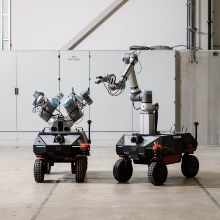Research Mission Cluster of Excellence IntCDC
The vision of the Cluster of Excellence Integrative Computational Design and Construction for Architecture (IntCDC) is to harness the full potential of digital technologies in order to rethink design, fabrication and construction based on integration and interdisciplinarity, with the goal of enabling game-changing innovation in the building sector as it can only occur through highly integrative fundamental research in an interdisciplinary, large-scale research undertaking.
Project description RP 26
The overall goal of RP 26 is to increase the efficiency, accuracy, and quality of exemplary indoor construction tasks with a group of collaborative heterogeneous mobile manipulators. Artificial Intelligence (AI) methods are used for path and trajectory generation and environment perception.
Optimization-based methods enable path and trajectory generation based on an environment model, minimizing execution time and maximizing accuracy. However, the complexity of the design scenarios, nonlinearities, the number of optimization variables, and uncertainties inhibit the real-time capability of the trajectory generation problem. For this reason, we are investigating decentralized approaches and the application of methods from AI (e.g., regression models, imitation learning, or reinforcement learning) to enable real-time trajectory generation and the consideration of sensor feedback for adaptive replanning.
This requires the development of indoor positioning and environmental sensing algorithms, using e.g. total stations, laser scanners, cameras and IMUs. We will exploit the capability of simultaneous localization and mapping (SLAM) algorithms for both positioning of mobile manipulators and acquisition of 3D information of the respective indoor environment. The goal is to modify and further develop high-precision SLAM approaches for real-time positioning and data acquisition for a digital twin of the construction site. This digital twin consists of an up-to-date, semantically enriched, consistent 3D model represented by a labeled 3D point cloud or a 3D voxel grid.

Alice Hierholz
M.Sc.Research Assistant



